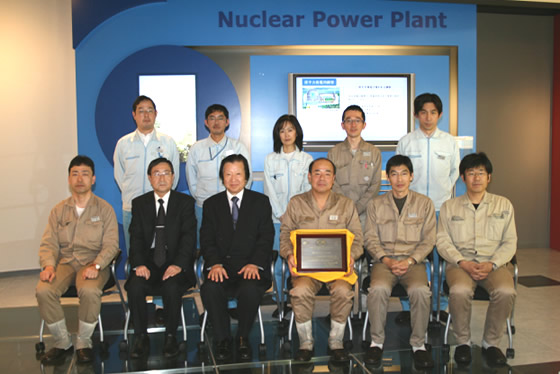Sumitomo Metals Receives ISOE Technical Awardfrom International Atomic Energy Agency
for its Development of Steel Tube Film Coating Technologies
Technological Advance Contributes to Improved Safety through Reduction of Nuclear Power Plants’ Occupational Radiation Exposure
2010.04.08
- Sumitomo Metal Industries, Ltd.
Sumitomo Metal Industries, Ltd. (Sumitomo Metals) has received the Technical Award from the Information System on Occupational Exposure (ISOE) Committee that is led by the joint secretariat of the OECD/NEA (Nuclear Energy Agency) and IAEA (International Atomic Energy Agency) at the ISOE Asia Symposium. The Committee awards technologies that serve to reduce radiation exposure of workers at nuclear plants. Sumitomo Metals was awarded for its contribution in realizing the world's lowest radiation level nuclear plant, by supplying its feed-water heater tubes that use the awarded filming technology.
Sumitomo Metals has become the first material maker to receive the ISOE Technical Award.
1. Development background and outline
Nuclear power generation has attracted attention globally from the viewpoint of reduction of carbon dioxide emissions and many plants are under construction or being planned in the world. One of the big challenges for widespread, effective utilization of nuclear power generation is to reduce occupational radiation exposure. The ISOE Committee targets to ultimately reduce nuclear power plant workers' radiation level close to the normal exposure level of nature.
Stainless and other steel tubes used in the nuclear power plants tend to release a minute amount of metal ion such as cobalt and chromium in the cooling water of a reactor. The ion tends to increase the amount of exposure, which has caused radiation exposure at the time of maintenance work of the generation plant. Consequently, it has become necessary to inhibit release of such ion for reducing radiation exposure.
Sumitomo Metals has succeeded, for the first time in the world, in manufacturing material which reduces the content of cobalt to a minute amount and developing a film processing technology, by which the oxidized film formed on the inner surface of tubes helps to reduce release of metal ion including cobalt and chromium from tubes.
2. Development outcome
This film processing technology was adopted at the boiling water reactor (BWR) type of a nuclear power plant, which has attained the world's lowest radiation level and has contributed to workers' radiation exposure
3. Future development
Sumitomo Metals aims at applying the new film technology for steam generator tubes in the widely-used pressurized water reactor (PWR) type of nuclear power plants, for contributing to reduction in occupational radiation exposure.
<Reference>
1. International Atomic Energy Agency (IAEA)
In response to U.S. President Eisenhower's address to the General Assembly of the United Nations in 1953, the IAEA was created in 1957 as an international organization to assist its member states in using nuclear science and technology for various peaceful purposes, and to prevent use of nuclear materials and technology for military purpose.
The IAEA's major activities today are,
(1) To mobilize peaceful applications of nuclear science and technology.
(2) To protect people and the environment from harmful radiation exposure such as managing nuclear installations, radioactive sources and waste.
(3) To prevent the further spread of nuclear weapons under safeguards agreements with many countries around the world.
2. Organization for Economic Co-operation and Development (OECD) / Nuclear Energy Agency (NEA)
The NEA was established in 1958 as a specialized agency within the OECD to assist member countries in maintaining and further developing the scientific, technological, and legal bases required for the safe environmentally friendly and economical use of nuclear energy for peaceful purposes. The main works include nuclear safety and regulation, nuclear energy development, radioactive waste management, radiological protection, and nuclear science.
The 28 current member countries of the NEA comprise most membership of the OECD.
3. Information System on Occupational Exposure (ISOE) Committee
The ISOE was established by the IAEA and the OECD/NEA in 1992 with the aim to exchange, accumulate, and analyze information on occupational exposure levels of each country for optimizing worker dosage in nuclear power plant.

The award ceremony
